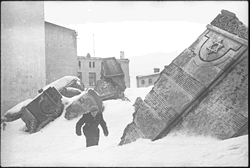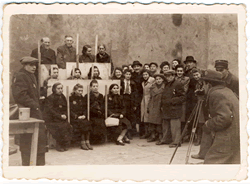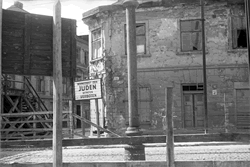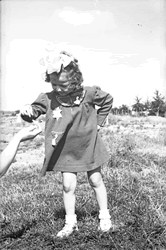Memory Unearthed: The Lodz Ghetto Photographs of Henryk Ross
http://jewishquarterly.org/2015/06/memory-unearthed-the-lodz-ghetto-photographs-of-henryk-ross-2/
Posted on 22/06/2015 by Ruth Ellen Gruber in Books, Essays, Featured, History, Reviews
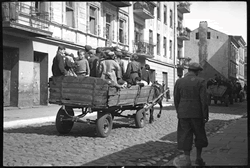
The extraordinary images reprinted in Memory Unearthed: The Lodz Ghetto Photographs of Henryk Ross are survivors, both physical and symbolic.
Ross, born in Warsaw in 1910, was one of the more than 200,000 Jews imprisoned in the World War II Lodz ghetto. Thanks to his background as a photo-journalist, he was appointed to a privileged position—an official photographer for the Statistics Office of the Ghetto’s Jewish Council (Judenrat).
He worked in that capacity from 1940 to 1945, taking thousands of photographs that documented the widest possible range of ghetto life—and death.
On the one hand, his official work produced everything from ID portraits and group photos of ghetto police, to Potemkin village-like shots of ghetto inmates, smiling at their benches as they laboured in Council-run workshops, or “resorts”, including those that employed young children.
But he turned his lens, too, on other scenes far outside the purview of propaganda—scenes of violence and mass deportations, scenes of murder and malnutrition, scenes of death. Often taken on the sly, from a camera hidden under his coat, these images are chilling but almost familiar in the Holocaust horror they depict.
Ross, though, also immortalized intensely personal moments that put the death, destruction and degradation in a much more intimate, even unlikely, context: kids at play, a smiling bride at her ghetto wedding, friends clowning, a couple stealing a kiss.
Ross, who survived the Holocaust and emigrated to Israel after the war, knew just what he was doing and just what he wanted to do.
“Having an official camera, I was secretly able to photograph the life of the Jews in the ghetto,” he wrote in 1987, four years before his death. “Just before the closure of the ghetto in 1944, I buried my negatives in the ground in order that there should be some record of our tragedy, namely the total elimination of the Jews from Lodz by the Nazi executioners. I was anticipating the total destruction of Polish Jewry. I wanted to leave a historical record of our martyrdom.”
In January 1945, after the Red Army liberated the ghetto, he went back and dug up what he had hidden. Fewer than 3,000 of the 6,000 negatives he had buried survived intact; others were severely damaged from seven months under ground.
But by bringing them back to light, he brought them, and what they represented, back to life. Ross unearthed not only shadowy strips of celluloid; he unearthed direct testimony to the cruelty of life inside the ghetto, and direct testimony, too, to life itself – the lives lived by ghetto inmates, intimate glimpses of humanity side by side with the horror.
Mai-Mari Sutnik, who edited Memory Unearthed, called them images of “cruel tragedies” and “consoling pleasures.”
“Each is more than an isolated frame: even if marked with trace damages, it is a moment in history,” she wrote in an introduction to the volume. “In Ross’s images […] one sees grace and anguish, hope and suffering, productivity and devastation.”
Looking through the photos in Memory Unearthed, I couldn’t help thinking of another Lodz Ghetto collection, a collection comprised of sounds, not images: a cycle of songs performed by the American klezmer group Brave Old World and issued as a CD in 2005.
Called “Song of the Lodz Ghetto,” the CD has at its heart songs that were sung in the Ghetto – sung perhaps, or even probably, by some of the people captured by Ross in his photos.
These songs were collected from survivors in the 1980s by the Israeli ethnomusicologist Gila Flam. The CD starts and ends with one of Flam’s actual recordings – the frail voice of survivor Ya’akov Rotenberg singing “Rumkowski Khayim,” a bitter send-up of Moredchai Chaim Rumkowski, the ghetto’s “Jewish elder,” head of the Judenrat for which Henryk Ross worked.
On the CD, these songs of the Ghetto are interwoven with traditional Polish klezmer tunes and Brave Old World’s own new Yiddish compositions to form an evocative, even dramatic, song cycle that explores both past and present.
“One of the greatest challenges in working on the Lodz material was to really grasp the three-dimensional reality that those were real, living people – teenagers, young people, people in their 20s — who went through that experience,” Brave Old World’s musical director, Alan Bern told me when I wrote a review of the CD not long after it came out.
“And now it’s in the past, a long time ago, and when we hear their voices they’re the voices of old people,” he said. “But we wanted to overcome that distance. To really kind of get into that world as much as we possibly could, not to just interpret but really get into the subjectivity of the people.”
Henryk Ross’s photographs have the same potent effect.
